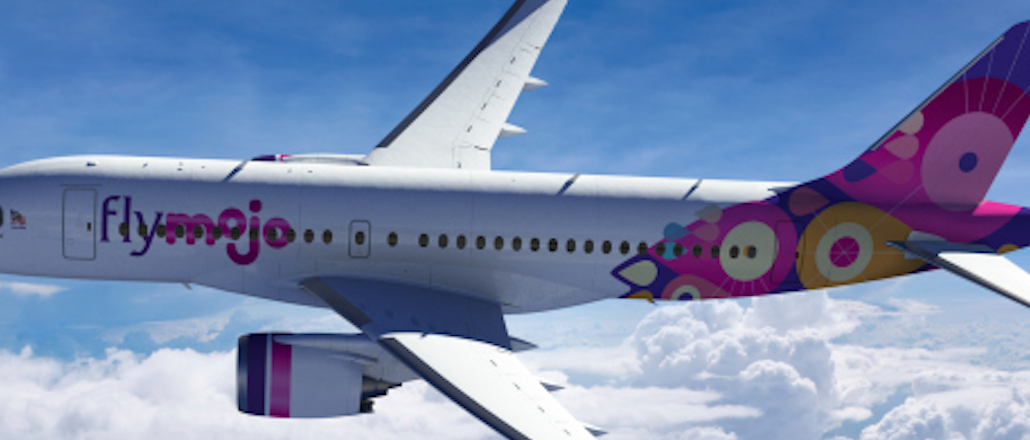
Malaysia is getting a new airline. A year after its national carrier Malaysia Airlines lost two flights, including the bizarre disappearance of Flight 370, the new airline, called flymojo, announced that it has inked a deal to buy 20 CS100 aircraft from Bombardier. It comes at a time when the regional aviation sector could use a bit of rebranding.
Set to take off in 2016 as a full-service air carrier, the new airline’s main hub will be in Malaysia’s southern state of Johor and its secondary hub in the island of Borneo. In addition to the beleaguered Malaysia Airlines, flymojo will face competition from low-cost carrier AirAsia.
It aims to improve connectivity between the Malaysian Peninsula and the island of Borneo, as well as the regional Southeast Asian market as a whole, according to Aziz Kaprawi, Malaysia’s Deputy Minister of Transport.
However, the aviation sector in region still struggles to get over recent tragedies: In addition to flight 370, Malaysian Arlines lost a passenger plane over the Ukraine after it was apparently shot down, and AirAsia’s flight 8501 crashed into the Java Sea.
With that in mind, a few strategy experts weigh in on how the airline can establish itself as a reliable brand.
Maintain a regional focus
According to Chetan Kapoor, Asia-Pacific research analyst at Phocuswright, the Southeast Asian regional market is robust. Airline capacity in Asia-Pacific increased 7 percent last year. Revenue is estimated to reach $165 billion this year, the largest globally. In spite of recent disasters, Malaysia remains a key economy in The Association of Southeast Asian Nations, accounting for over one-fourth of the tourism arrivals into ASEAN alone in 2013. “There is definitely headroom for growth – and steal share from other carriers – despite challenges faced by some,” he said.
Having a strategic regional focus would also enable it to connect key international destinations with Southeast Asia easily. It would also benefit its target customers who currently only have AirAsia to rely on for non-stop connectivity between these destinations, giving them more choice in terms of price and timings.
“It’s an opportune time for a new brand to make its entry because the region needs it and Malaysia needs it,” Jason Sullivan, managing director of Publicis Seattle, told Digiday.
Provide value and create an experience
Competing on price alone won’t be enough. Instead, flymojo should find a way to truly blend value with cheap fares.
“Other operators in the region already focus on low costs,” said Jason Clampet, co-founder and head of content at Skift. “They should focus on quality and make their brand about customer service.”
From the statement that the airline released on Wednesday, it appeared that flymojo understands this. The airline aims “to make air travel a much-anticipated and longed for experience,” said chairman Alies Anor Abdul. It will provide value and “exceptional customer service that will focus on putting the human touch back into flying.”
That, Brock Montgomery, evp of creative services at agency Upshot, said would come with time.
“I would stress the attention to detail that goes into every flight, whether that is talking about maintenance, security, customer service or the in-flight experience,” he said. “Most importantly, they need to practice what they preach — prove it for real, one flight at a time. Not just offer up a slick campaign and a bunch of promises.”
Be honest and accountable
People are understandably wary of regional airlines after last year, making this an opportunity to give new life to the space. This can be done, according to experts, by being transparent and building credibility.
To that end, it can learn from its competitor AirAsia.
“When the AirAsia flight crashed in December, it meant a lot to people to see [AirAsia CEO] Tony Fernandes publicly take charge and responsibility and gave the airline credibility,” said Clampet. “Malaysia Airlines did not communicate that well, at least during MH370.”
Flymojo’s fleet includes the new family of “ultra-modern” CS100 aircrafts from Bombardier Inc. Another way to gain credibility, according to Matt Norcia, executive director of development at Brand Union, is to align more strongly with the Canadian-based Bombardier and dispel any safety concerns.
“They should highlight that a lot more to combat the safety perception,” he told Digiday. “It would really help to align with Bombardier. That has a great history of quality, consistency and security.”
“It’s truly a performance issue more than a marketing one,” added Montgomery.
Redefine modernity
“Flymojo cannot just merely meet modern value standards, but has to exceed them,” said Sullivan. “And defining that promise of modernity includes the body language of the business too.”
He added that the airline’s name itself evokes a sense of confidence and swagger. Its uniforms are just as equally modern and colorful.“It is reminiscent of the same cool vibe that one gets from a brand like Virgin,” he said.
Lastly, a clear digital strategy would also help flymojo build its appeal as a modern carrier. “Competitors have years of experience and knowledge under their belt,” Kapoor said. “Flymojo should come out of the gates with a clear digital strategy, including online and mobile booking tools, social presence and marketing.”
More in Marketing

In Graphic Detail: Why YouTube is a genuine threat to Netflix
Digiday has charted exactly how YouTube is a real threat to Netflix, due to its dominance of watch time, user base and its ability to totally reshape viewing behaviors.

At Ebiquity, a new role signals marketing’s shift from metrics to meaning
Marketing has no shortage of data. Ebiquity is betting on judgement.

Lowe’s wants to do more with AI shopping in 2026
Mylow, a shopping assistant powered by ChatGPT that launched in March, is already driving double the conversion rate for online shoppers.





